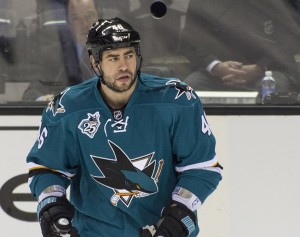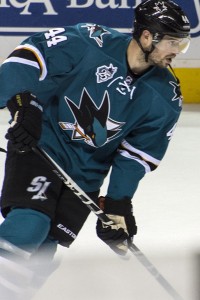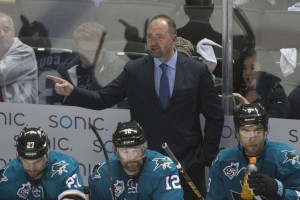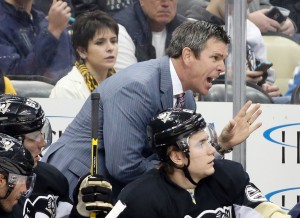Well, there it was. A day ago, with much ado about Matt Nieto’s return to the lineup. I wrote that it was much ado about the wrong thing. The real ado was the Sharks needing to play their game, not Pittsburgh’s game. Nieto was in Game 2, but he was not key to the game. He is not the key to the series.

Before the series started, I wrote about the lineup adjustment I felt Sharks coach Peter DeBoer might need to make, swapping in defenseman Dylan DeMelo, a better puck mover, for Roman Polak. I was especially concerned about Polak’s issues with getting the puck cleanly out of his own zone. That showed up huge in Game 2. Polak’s puck handling error resulted in Pittsburgh’s regulation goal. While San Jose did come back to tie the game, an overtime goal from the Penguins’ Conor Sheary made the final 2-1, and put Pittsburgh up in the series 2-0.
The Scoreboard and the Play
Both games were there for the Sharks to steal. The scoreboard said the games were close. The on-ice play has not been close. Only the exceptional effort of Sharks goalie Martin Jones has kept the Sharks in the two games.

Game 2 was somewhat more to the Sharks style, the heavier of the two games. Pittsburgh may be smaller, but they played bigger than they are and San Jose played smaller. When it comes to San Jose passing the puck up the ice, the Pens have been waiting in passing lanes. It is almost like they watched video and somehow figured out the Sharks’ playbook.
In both games, San Jose played hurried hockey instead of disciplined hockey. In the first minute of Game 2, the Sharks turned the puck over three times trying to move the puck up ice, a fourth attempt resulted in an icing. If one was looking to see if San Jose had figured out a new approach to advancing the puck, it was pretty clear from the opening minute they had not.
The Sharks need to adapt or this series will be over quickly. Two adjustments are most important. First, San Jose need to use different zone exit plays — the Pens know the Sharks’ playbook at least as well as the Sharks know it. They know what is coming. Second, San Jose needs to be the heavy team and win the heavy battles. Their bigger, stronger players need to win puck battles and hold onto the puck. A better commitment to puck support should help both areas. Removing the larger Dainius Zubrus for speedier Matt Nieto was not impactful. San Jose needs to make the game more physical and win the big boys game.
http://gty.im/536222646
Sharks players must win their battles against smaller opponents. Nick Bonino gives up 3 inches and 30 pounds to Joe Thornton, but won a puck battle. Carl Hagelin gives up 3 inches and 40 pounds to Brenden Dillon, but still took the puck from him leading to a goal in Game 2. In Game 1, it was Hagelin winning a puck battle against the bigger Tomas Hertl which led directly to the Penguins’ game-winning goal. On both of the Hagelin plays, the Sharks player had better position to start the battle. The smaller Pittsburgh guy taking the puck from bigger San Jose guy has happened all over the ice for most of both games. On paper, it says the Sharks should be winning the physical battles. On the ice, its not happening.
The Penguins are outfoxing and outmuscling the Sharks. San Jose must be smarter and stronger than they’ve been.
One Effective Adjustment

The Sharks are reeling. They are down. They are not out. Things can turn in a hurry, but Peter DeBoer will need to make the right adjustments and the players will need to upgrade their play.
The Sharks did make one effective improvement between Game 1 and Game 2. They stayed structured and did not give the Pens nearly as much early offense or odd-man rushes. In Game 1, all three Pens goals were scored within eight seconds of their entry into the offensive zone. In Game 2, the goals came off the Polak misplay and a face-off win following an icing. If nothing else, at least San Jose cleaned up one important area. It is something to build on. For all Pittsburgh has dominated play, goals are not coming easily. Take out their quick-strike capability and the Pens may find it much tougher to score. The Sharks’ ability to get their defense set and not allow Pittsburgh’s quick-strike attempts was perhaps Game 2’s biggest positive for San Jose.
The Panic Button

Sometimes, it helps to make a big change. Hit the panic button. In the series, the Sharks have struggled to match the forward depth of Pittsburgh. San Jose has a move which can change this. His name is Brent Burns. Burns was an excellent winger, he is now an excellent defenseman. Burns’ once weak defensive game is now a very good one. Burns’ play in the postseason, including this series, has been very good. He is a major asset on the blue line and has been their best defenseman this series, in all three zones.
In this series, the Sharks scored one even-strength goal with Burns on the ice. On that shift, he played like a power forward. He took the puck down low and went behind the net, scrambling the Penguins’ defenders. Moving Burns to a wing would push a player, most likely Nieto, out of the top three lines, allowing the Sharks to match Pittsburgh’s forward depth. Burns’ ferocious forecheck could be a series changer. Moving Burns would also create a huge hole on the Sharks’ blue line. I’d say it could be a series changer the wrong way for San Jose, but this series is already going the wrong way for San Jose.
Moving Burns is a panic button move, one which seems to carry a lot of risk. But given the direction of the series and the matchup problems Pittsburgh’s forwards have created for every one of their opponents in the playoffs (including the first two games of this series), the move isn’t as panicky as it might seem.
The Battle Within
I’m going to assume DeBoer doesn’t hit the panic button. In order for the two tactical changes recommended in this article to work for San Jose, they must win another battle. The challenge is an internal battle.

Hall of Fame football coach John Madden once opined on teams who reached the Super Bowl and players who said things like “I’m just happy to be here.” Madden noted the teams that were ‘just happy to be here,’ lost. The Penguins do not seem at all pleased to have reached the Stanley Cup Final. When asked about what he expected in Game 1, DeBoer expected a feeling-out period. Penguins coach Mike Sullivan was expecting his team to be pedal to the metal from the opening puck drop. This captures the difference in urgency. Right now, the Penguins are playing fierce hockey — every player, every shift. After Game 2, DeBoer said, “We’re playing a team that wants to win as badly as we do and is a very good team.” From the looks of the play, Pittsburgh wants it more. Credit Pittsburgh in another way. They want it, they play intense, but they stay disciplined. Concurrently maintaining tremendous intensity and tremendous discipline is a major challenge, individually and collectively. The Pens are thriving by doing both well.
Perhaps at some level, the Sharks were more content with their accomplishment of reaching the Western Conference Final. They may want the Stanley Cup, but they are not matching the moment-to-moment urgency of their opposition.
Unless the Sharks find a new level of urgency, their trip to the Stanley Cup Final is going to be short and not very sweet.
Zeke’s Notes
Logan Couture will not win many friends among officials with his postgame comment about Sidney Crosby being allowed to cheat in the face-off circle. This is the second time Couture has come off thin-skinned in the postseason, his remark about Drew Doughty’s comments after Rd. 1 was the other. I doubt this helps Couture in the bigger picture.
Through two games and over 122 minutes of playing time, the score has been tied or a one-goal differential 92 percent of the time. Its been tied or a one-goal differential 100 percent of the time in the third period. Yet San Jose has yet to hold the lead at any point so far in the series.